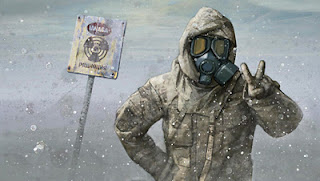The brilliant scientist Dr. Paul Armstrong and his wife Betty take to the woods in search of a meteor laden with the rare radioactive substance known as "atmospherium". Once they find it, they take it to their rented cabin in order to study it. Little do they realize that their discovery was noticed by Kro-Bar and Lattis, two aliens from the planet Marva who need to replenish their spacecraft's fuel supply (which happens to be atmospherium). Out of desperation, the two aliens decide to take it by deception. While the aliens are relatively harmless, their pet mutant who escaped during the crash has begun to commit a series of "horrible mutilations". The aliens aren't the only ones who want the atmospherium, though; the evil scientist Dr. Roger Fleming intends to use it to reanimate the titular "Lost Skeleton of Cadavra" as part of an entirely unexplained plot to take over the world.
 |
| No scientist is complete without his trusty Geiger counter |
Kro-Bar and Lattis use their "transmutatron" to make themselves look human (it changes their metallic spacesuits into a suit and a dress respectively) and get themselves invited to dinner at the cabin. Dr. Fleming, who knows about the aliens, also decides to drop in on the Armstrongs. Since he thinks he'll look suspicious if he arrives at the cabin alone, he uses the aliens' transmutatron (which they carelessly left behind) to transform a group of animals into a human woman that he names "Animala". A hysterically funny dinner scene ensues as the aliens attempt to emulate human eating customs but unwittingly end up following Animala's feral habits instead. Eventually, the atmospherium is stolen, the lost skeleton is reanimated, the mutant shows up, and a distinctly bizarre wedding à la Bride of the Monster (1955) is inexplicably introduced into the story.
 |
| The skeleton actually has some of the best dialogue |
Like I said, Blamire is obviously a huge 1950s b-movie fan, which is reflected in The Lost Skeleton of Cadavra. The aliens' costumes, the low-budget spaceship exterior, and the stilted dialogue would be familiar to anyone who has seen an Ed Wood movie, particularly Plan 9 from Outer Space (1959). For example, this deliberately humorous line from Lost Skeleton:
"Seriously, Betty, you know what this meteor could mean to science. If we find it, and it's real, it could mean a lot. It could mean actual advances in the field of science."isn't a whole lot more awkward than this one from Plan 9:
"We are all interested in the future, for that is where you and I are going to spend the rest of our lives. And remember my friend, future events such as these will affect you in the future."While many references to the genre are recognizable to non-fans (e.g., an awful mutant costume that's still better than many costumes from the era, low quality models and sets, visible wires, the inevitable scene in which the monster walks off with the heroine), others are more subtle. For example, the fact that Dr. Armstrong is a 'scientist who studies science' is constantly emphasized (an unusual number of b-movie heroes were scientists who had an unrealistically broad knowledge of all fields of science). B-movie fans will immediately recognize that The Lost Skeleton of Cadavra was filmed on location at Bronson Canyon; a portion of Griffith Park in Los Angeles that became the setting for dozens of budget-strapped b-movies. And fans will also appreciate that the actor in the mutant suit is obviously struggling to carry Betty over the rough terrain (Ro-Man had the the very same problem in the exact same canyon in Robot Monster (1953)).
 |
| RAWWWR! |
The only place where The Lost Skeleton of Cadavra stumbles is where it deviates from the b-movies that it emulates; its running time. Robot Monster was 66 minutes long, Bride of the Monster was 69 minutes long, and Plan 9 from Outer Space ran for an excruciating 79 minutes. At the time those films were made, audiences expected a feature film to last just over one hour. Although the makers of The Lost Skeleton of Cadavra intended for it to be an homage to '50s sci-fi movies, they made it 90 minutes long; i.e., closer to the length of a modern film. Although Lost Skeleton remains funny throughout, it starts to sputter around the one hour mark. The judicious removal of 20 or 25 minutes of material would not only have given Lost Skeleton a running time similar to those of the movies that inspired it, but also would have made it a slightly better film.
B+






















